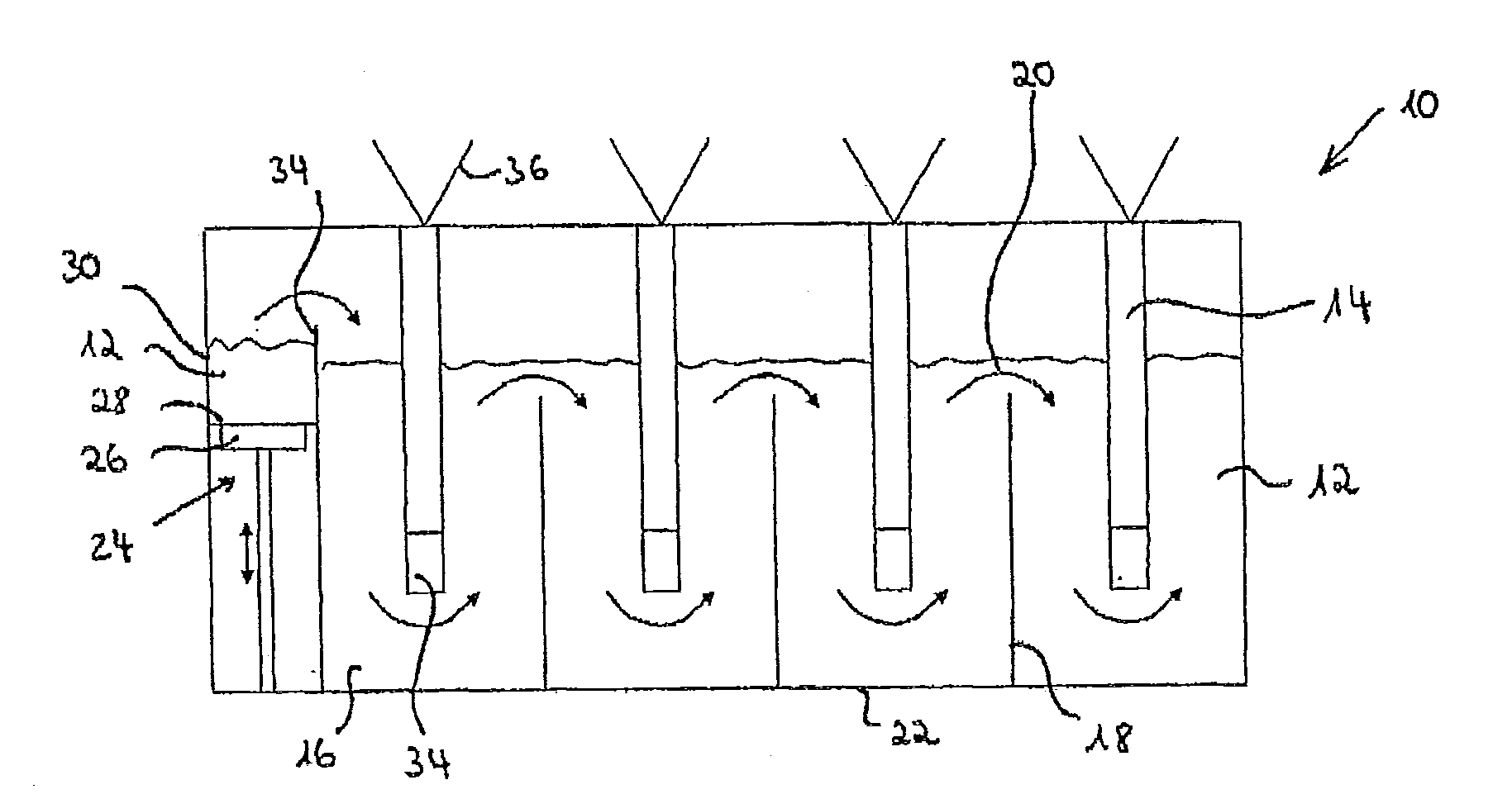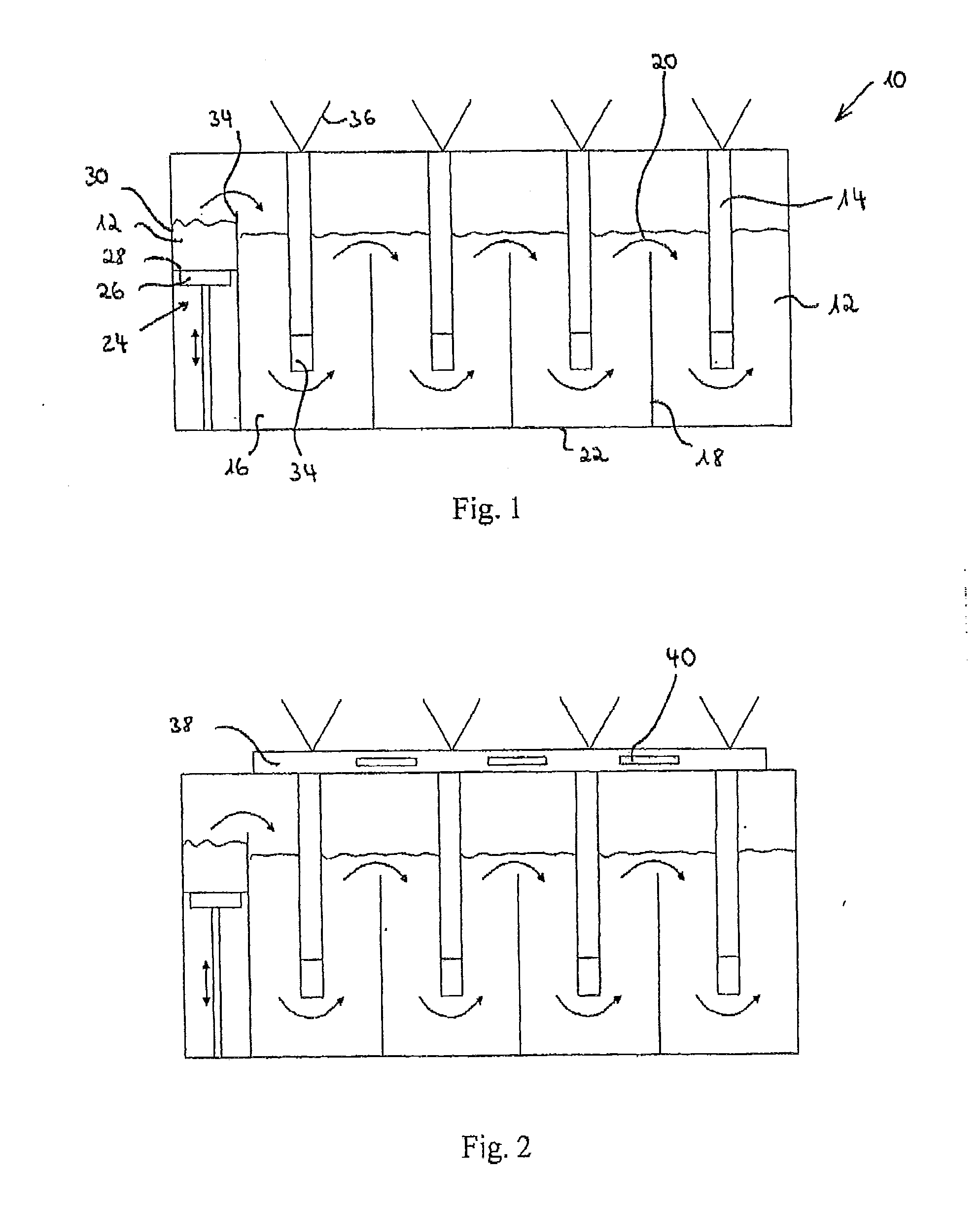Breeding and reproduction system for light-intensive microorganisms (such as algae)
a technology for microorganisms and reproduction systems, applied in the field of system for raising and reproducing microorganisms, can solve the problems of reducing the growth of sensitive microorganisms, low algae yield per hectare, etc., and achieve the effect of constant energy and uniform distribution
- Summary
- Abstract
- Description
- Claims
- Application Information
AI Technical Summary
Benefits of technology
Problems solved by technology
Method used
Image
Examples
first embodiment
[0034]FIG. 1 shows a schematic representation of an inventive system for breeding and reproduction shown by micro-organisms, with a basin system 10 that has arranged in the basin plant, a nutrient suspension 12, the basin system 10 is formed by partitions 14 of vertical meanders or baffle material configured to achieve substantially vertical flow of the nutrient suspension 12 in the basin system 10. The basin system 10 is composed of several adjacent, open, U-shaped basins or pools 16, in which is immersed in each basin 16, a vertical partition 14. Each tank 16 has side walls 18, the side walls 18 of adjacent basin 16 an over flow area 20, designed to allow the nutrient suspension 12 to travel from a basin 16 into an adjacent basin. Within the basin system 10, the nutrient suspension follows an essentially vertical flow path indicated by arrows in the area between a side wall 18 and a partition 14. In the overflow area 20 and in the area between the pool bottom 22 and the lower end ...
second embodiment
[0041]As shown in FIG. 2, the partitions 14 may be connected according to the invention, disclosing a web 38, which is hollow and can optionally contain dispersive liquid. The web 38 can direct the dispersive liquid from one partition 14 to the next partition, so that a permanent replacement of fluid is currently is provided and the circulation of dispersive liquid is achieved. The web 38 may possess heaters and / or cooling elements 40 which may be arranged with the help of which one is set for the growth of microorganisms optimum temperature. Since the bridge 38 is preferably located above the basin system 10, it can serve as a light collector of sunlight, with the collected sun light emitted through the liquid to disperse the individual partitions 14.
[0042]FIG. 3 shows schematically an embodiment of a partition 14 is shown having a tubing 42, through which the dispersive liquid inside the partition walls 14 can be performed so that a uniform temperature distribution along the parti...
third embodiment
[0044]FIG. 5 shows a schematic representation of an inventive system in which the nutrient suspension is introduced 12 by a pump 44 into the basin system 10. Underneath the individual pools, a flow channel 46 is arranged, which is fed by the nutrient suspension 12 in the individual basins 16. After the exit of the nutrient suspension 12 from the last tank, it will be again by the pump pumped through the flow channel 46 back into the first tank so that it creates a flow circuit of the nutrient suspension.
PUM
 Login to View More
Login to View More Abstract
Description
Claims
Application Information
 Login to View More
Login to View More - R&D
- Intellectual Property
- Life Sciences
- Materials
- Tech Scout
- Unparalleled Data Quality
- Higher Quality Content
- 60% Fewer Hallucinations
Browse by: Latest US Patents, China's latest patents, Technical Efficacy Thesaurus, Application Domain, Technology Topic, Popular Technical Reports.
© 2025 PatSnap. All rights reserved.Legal|Privacy policy|Modern Slavery Act Transparency Statement|Sitemap|About US| Contact US: help@patsnap.com



